Security researchers say they’ve found more than a dozen iPhone apps covertly communicating with a server associated with Golduck, a historically Android-focused malware that infects popular classic game apps.
The malware has been known about for over a year, after it was first discovered by Appthority infecting classic and retro games on Google Play, by embedding backdoor code that allowed malicious payloads to be silently pushed to the device. At the time, more than 10 million users were affected by the malware, allowing hackers to run malicious commands at the highest privileges, like sending premium SMS messages from a victim’s phone to make money.
Now, the researchers say iPhone apps linked to the malware could also present a risk.
Wandera, an enterprise security firm, said it found 14 apps — all retro-style games — that were communicating with the same command and control server used by the Golduck malware.
“The [Golduck] domain was on a watchlist we established due to its use in distributing a specific strain of Android malware in the past,” said Michael Covington, Wandera’s vice-president of product. “When we started seeing communication between iOS devices and the known malware domain, we investigated further.”
The apps include: Commando Metal: Classic Contra, Super Pentron Adventure: Super Hard, Classic Tank vs Super Bomber, Super Adventure of Maritron, Roy Adventure Troll Game, Trap Dungeons: Super Adventure, Bounce Classic Legend, Block Game, Classic Bomber: Super Legend, Brain It On: Stickman Physics, Bomber Game: Classic Bomberman, Classic Brick – Retro Block, The Climber Brick, and Chicken Shoot Galaxy Invaders.
According to the researchers, what they saw so far seems relatively benign — the command and control server simply pushes a list of icons in a pocket of ad space in the upper-right corner of the app. When the user opens the game, the server tells the app which icons and links it should serve to the user. They did, however, see the apps sending IP address data — and, in some cases, location data — back to the Golduck command and control server. TechCrunch verified their claims, running the apps on a clean iPhone through a proxy, allowing us to see where the data goes. Based on what we saw, the app tells the malicious Golduck server what app, version, device type, and the IP address of the device — including how many ads were displayed on the phone.
As of now, the researchers say that the apps are packed with ads — likely as a way to make a quick buck. But they expressed concern that the communication between the app and the known-to-be-malicious server could open up the app — and the device — to malicious commands down the line.
“The apps themselves are technically not compromised; while they do not contain any malicious code, the backdoor they open presents a risk for exposure that our customers do not want to take.
“A hacker could easily use the secondary advertisement space to display a link that redirects the user and dupes them into installing a provisioning profile or a new certificate that ultimately allows for a more malicious app to be installed,” said the researchers.

One of the iPhone apps, “Classic Bomber,” which was spotted communicating with a malicious command and control server. It’s since been pulled from the U.S. store. (Screenshot: TechCrunch)
That could be said for any game or app, regardless of device maker or software. But the connection to a known malicious server isn’t a good look. Covington said that the company has “observed malicious content being shared from the server,” but that it wasn’t related to the games.
The implication is that if the server is sending malicious payloads to Android users, iPhone users could be next.
TechCrunch sent the list of apps to data insights firm Sensor Tower, which estimated that the 14 apps had been installed close to one million times since they were released — excluding repeated downloads or installs across different devices.
When we tried contacting the app makers, many of the App Store links pointed to dead links or to pages with boilerplate privacy policies but no contact information. The registrant on the Golduck domain appears to be fake, along with other domains associated with Golduck, which often have different names and email addresses.
Apple did not comment when reached prior to publication. The apps are appear to still be downloadable from the App Store, but all now say they are “not currently available in the U.S. store.”
Apple’s app stores may have a better rap than Google’s, which every once in a while lets malicious apps slip through the net. In reality, neither store is perfect. Earlier this year, security researchers found a top-tier app in the Mac App Store that was collecting users’ browsing history without permission, and dozens of iPhone apps that were sending user location data to advertisers without explicitly asking first.
For the average user, malicious apps remain the largest and most common threat to mobile users — even with locked down device software and the extensive vetting of apps.
If there’s one lesson, now and always: don’t download what you don’t need, or can’t trust.

from TechCrunch https://tcrn.ch/2C092Gq

![]() The Economist:
The Economist:



 : Maria Pointer
: Maria Pointer 




